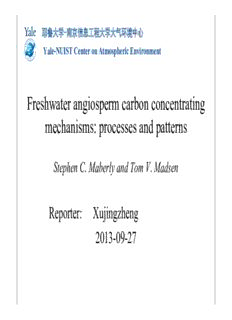
Freshwater angiosperm carbon concentrating mechanisms PDF
Preview Freshwater angiosperm carbon concentrating mechanisms
耶鲁大学-南京信息工程大学大气环境中心 Yale-NUIST Center on Atmospheric Environment Freshwater angiosperm carbon concentrating mechanisms: processes and patterns Stephen C. Maberly and Tom V. Madsen Reporter: Xujingzheng 2013-09-27 What are these plant carbon concentrating mechanisms? 2012/7/20 2012/9/6 2011/12/14 2012/10/11 2013/1/27 Outline Background Objective Results Structural and morphological features Physiological and biochemical features (1.CAM 2.C 3.HCO -) 4 3 Conclusions Discussion 1.Background CAM 水网藻 plant c4 Lobelia HCO - 3 1.Background • Aquatic angiosperms are derived from terrestrial ancestors and appear to have re-invaded water on many occasions. ( ) Maberly •While removing problems of water supply and reducing the need for supporting tissue, freshwaters have a potentially low and fl uctuating supply of CO for photosynthesis, as well as generally low 2 light. •As we known rates of CO2 diffusion in water are ten thousand times lower than in air, and diffusive transport can be a major limitation of macrophyte photosynthesis (Raven 1970). In many waters, particularly productive lakes, rapid photosynthetic uptake of inorganic carbon can reduce surface concentrations of CO2 close to zero.(Maberly 1996) 2.Objective • This paper will review published work and present new information on the structural, morphological, physiological, and bioche-mical features of fresh water macrophytes in the context of maximising net carbonuptake, and will discuss how inorganic carbon may influence macrophyte ecology. 3.Results 3.1 Structural and morphological • Macrophytes in relatively shallow water can obtain co from the atmosphere via 2 aerial or floating leaves • They possess a cuticle ,stomata and sub- face stomata cavities ,epidermal cells with- out chloroplasts ,and several layers of mesophyll cell with chloroplasts. • Possession of roots became necessary by the evolution of ter- restrial homiohydric tracheophytes. 3.1 Structural and morphological features • The morphology of submerged leaves often consist of two layers of cells, with chloroplasts in both layers. • This feature can deficit lack of water, and it also reduces self-shading in a generally low-light environment • Moreover,this feature can make better use of carbon supply. (from Wikipedia ) . 3.2.1 crassulacean acid metabolism Littorella uniflora • CAM(crassulacean acid metabolism) • CAM is now known in four other genera of aquatic vascular plants: Crassula, Littorella, Sagittaria and Vallisneria. • CAM isoetids take up inorganic carbon in the dark and fix this to form malate. CAM process and patterns • (Crenim at en.wikipedia )
Description: